Whenever someone mentions British food, fish and chips will inevitably come to mind. This quintessential dish is one of the UK’s most famous exports, and rightfully so. There’s nothing more comforting than soft slices of fish encased within crispy batter served together with fluffy chips.
However, British food is much more than just this world-renowned favourite. Whether its a full English breakfast with a plethora of items, the peculiar “bangers and mash”, or the quaint scotch egg, British foods typically have a long and storied history. Some are even regional specialties which means that you have to travel to a certain location to try them.
To get you started, here are some unique British foods that you should try when you next visit the UK!
1. Haggis, neeps and tatties
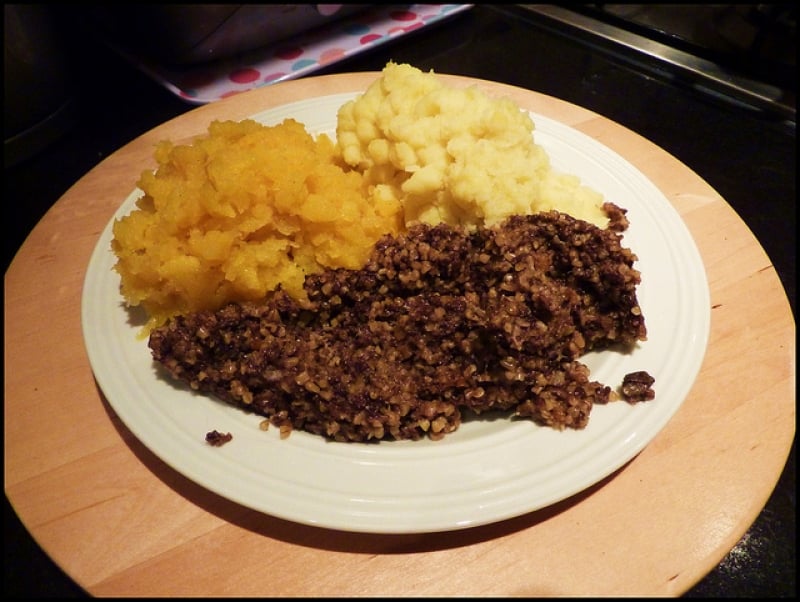
Image credit: Stuart Chalmers
This ominous-looking black mixture is haggis, a traditional Scottish dish constituting sheep’s offal (heart, liver, and lungs), minced with onions, oatmeal, suet, spices, and salt. It is then combined with stock and simmered in the animal’s stomach. This intriguing combination of ingredients is also known as the national dish of Scotland!
While haggis is eaten all year round, it is traditionally associated with Burns Night, the birthday of national poet Robert Burns, who wrote the poem “Address to a Haggis”. It is also often served together with neeps and tatties, which are boiled and mashed rutabagas (yellow root vegetable) and potatoes respectively. Don’t let its looks put you off — when in Scotland, do as the Scots do and have a taste of haggis!
2. Pie and mash with jellied eels
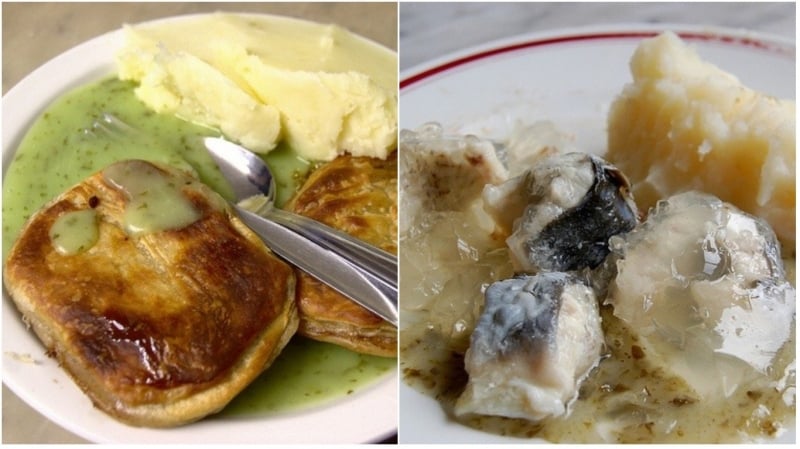
Image credits: (left) Scott Sherrill-Mix, (right) Uglix
A food of the working-class, this savoury pie is filled with minced meat (usually either beef or mutton) and is served with mashed potato. The pie is generously topped with an eel-based parsley sauce called eel liquor sauce (although it is non-alcoholic). This dish originated in London during the 19th century, and is comfort food at its best.
If you’re game, you can pair your pie with some jellied eels, which are chopped eels that are boiled in a spiced stock and allowed to cool, forming a gelatinous jelly. It might look rather slimy, but who knows, you might come to like it!
3. Shepherd’s pie
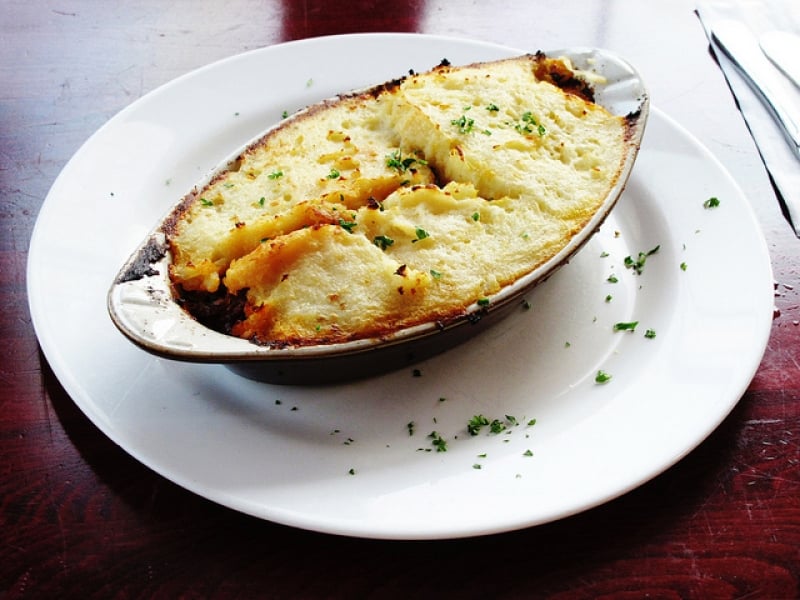
Image credit: wEnDy
A Shepherd’s pie is a meat pie consisting of minced lamb cooked in a gravy with onions and other vegetables, and topped with a mashed potato crust. If minced beef is used instead, it is called a cottage pie. It was introduced as a way to use leftover roasted meat in the 19th century, and is regarded as a comfort food. On a cold day, digging into the soft crust and releasing the steam from the piping hot ingredients underneath feels like pure bliss.
4. Bangers and mash

Image credit: Steven Tan
‘Bangers’ is a British term used to refer to sausages, and has its origins from World War I. Due to meat shortages, sausages were made with very little meat and were mostly water, and would pop under high heat when cooked, which sounded like mini-explosions or ‘bangs’.
Nowadays these sausages are served with mashed potatoes and topped with onion gravy, fried onions, or peas. This classic dish is also an example of ‘pub grub’, which is food that can be easily made in large quantities to be served in pubs. The starchy mixture pairs perfectly with a pint of beer!
5. Sunday roast
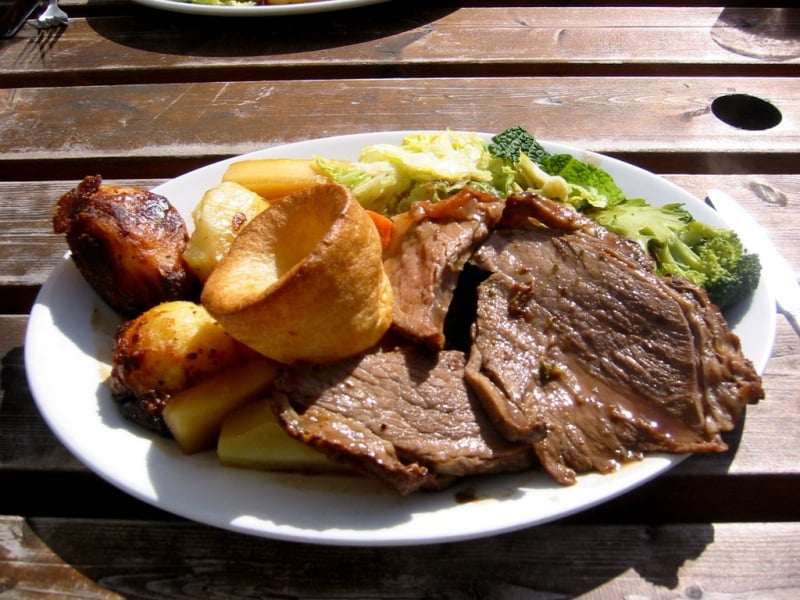
Image credit: Jeremy Keith
A Sunday roast is a meal comprising of roasted meat and potatoes, accompanied with Yorkshire Pudding and vegetables, topped with gravy. It is traditionally served on Sunday, hence the name. It originated in the late 1700s, where families would place a cut of meat and vegetables in the oven before going to church on Sunday, and when they returned, the meal would be ready.
6. Full English breakfast
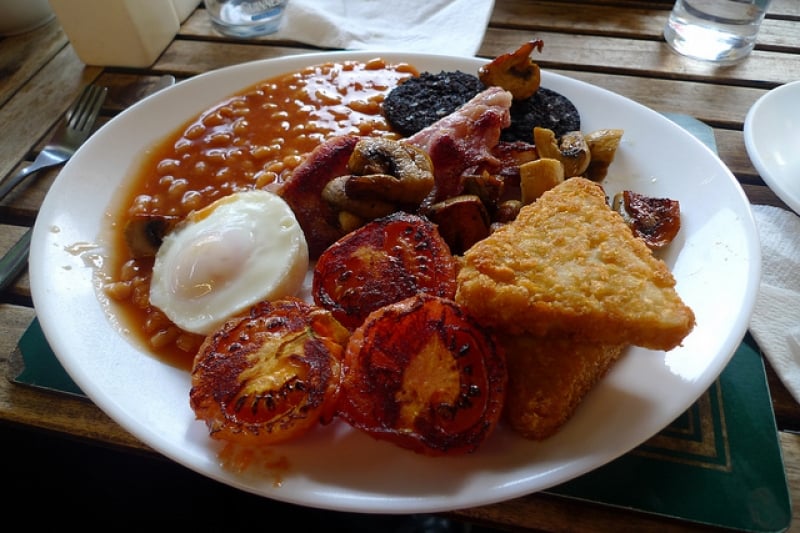
Image credit: Ewan Munro
Few nations do breakfast better than the British, and a full English is the perfect breakfast dish to wake up to. The exact items that go into a full English differ according to where it’s served. The ingredients normally include: grilled bacon, sausages, baked beans, grilled tomatoes, poached eggs, fried bread, sauteed mushrooms, hash browns, and black pudding — a sausage-like patty made with oatmeal, pork fat, and blood.
Also known as a ‘fry up’, this unhealthy but filling breakfast will surely nourish you for the rest of the day!
7. Beef Wellington
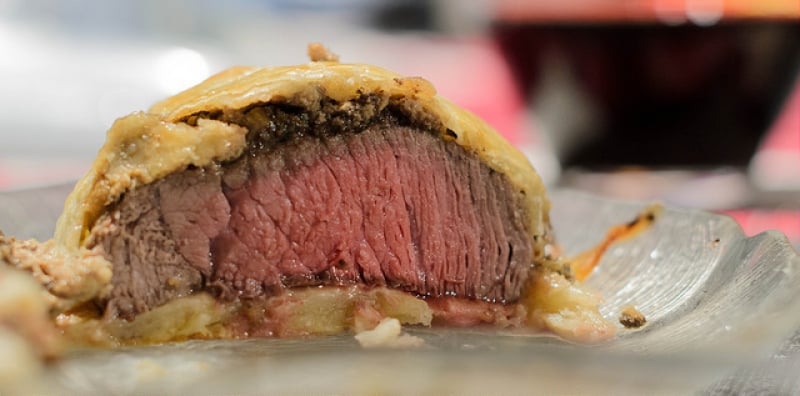
Image credit: Dale Cruse
A Beef Wellington is a tenderloin coated with pâté and duxelles (a paste made out of mushrooms, onions and herbs), wrapped in puff pastry and baked. It may be served with roasted potatoes or vegetables, together with gravy. The coating of pastry helps to provide a crisp texture and keep the meat inside juicy.
The origin of its name is unclear, with no direct connection to the Duke of Wellington, and may just have been a British rebranding of the French dish filet de bœuf en croûte (Filet of beef in pastry). Nevertheless, this dish has now become world-famous and is a gourmet treat you must try while in the UK.
8. Bacon butty
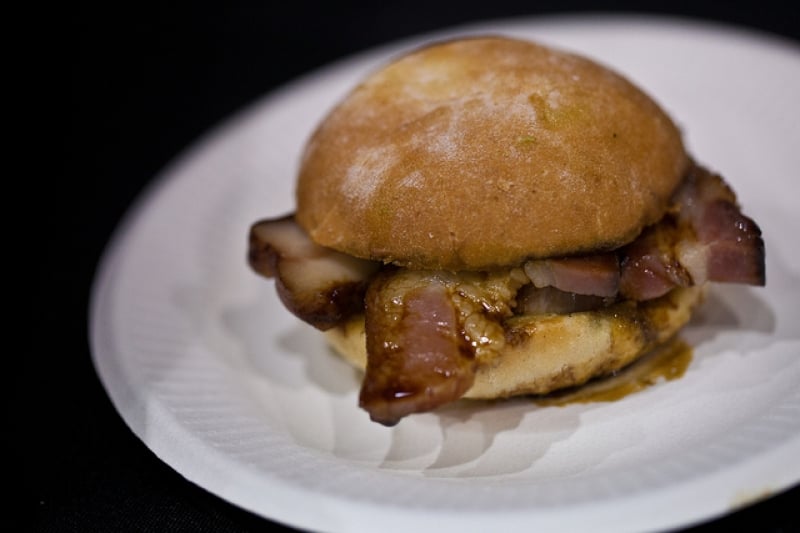
Image credit: opacity
Also known as a bacon bap or bacon sarnie, this dish is essentially a sandwich stuffed with slices of bacon and topped with brown sauce. This comforting dish full of salty goodness can be eaten at any time of the day, whether it’s for a hearty breakfast, an afternoon snack, or a post-clubbing treat to soak up the alcohol. Weight-watchers, you might want to stay away!
9. Cornish pasty
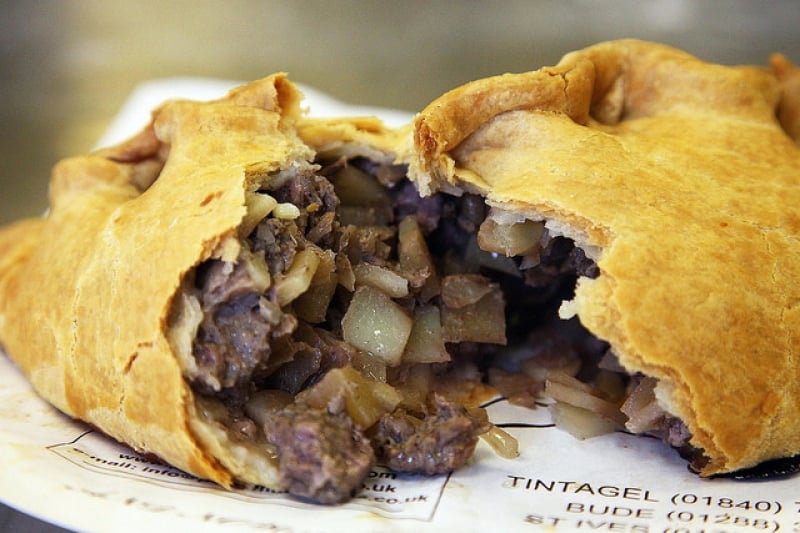
Image credit: Paul Townsend
A Cornish pasty is a semi-circle shaped pastry filled with beef, diced potato, rutabaga, and onion, before being baked. It is traditionally associated with Cornwall, a county in South West England, and is regarded as their national dish. It became popular with the working class as its unique shape meant it was a complete meal that could be carried around easily. You might find that it looks like a Southeast Asian curry puff!
Due to a campaign by the Cornish Pasty Association, the Cornish pasty has been awarded Protected Geographical Indication status by the European Commission. This means that its shape and ingredients must be standardised to be called as such, and it must be prepared in Cornwall.
10. Scotch eggs
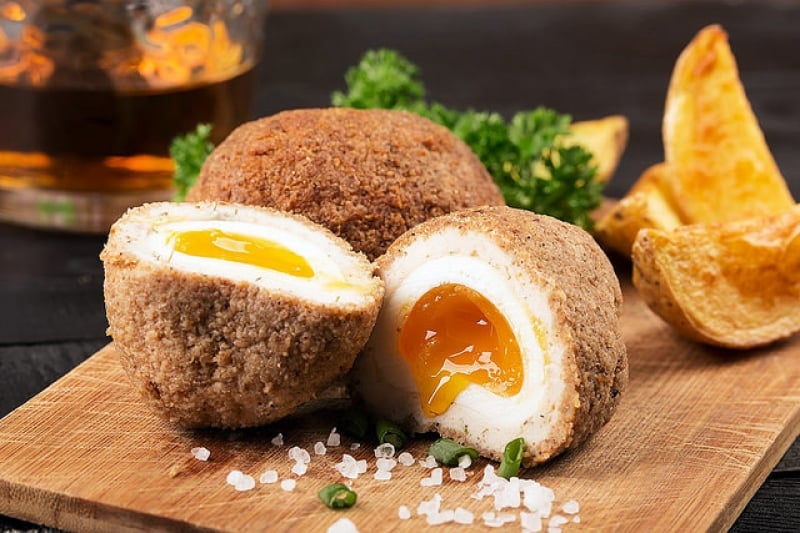
Image credit: Paul Townsend
A Scotch egg consists of a hard-boiled egg wrapped in sausage meat, before being breaded and baked or deep-fried. They are a common picnic food and available everywhere in the UK. Its origin dates back to 1738, with the London department store Fortnum & Mason claiming to have invented them, although they may have been inspired by the Mughlai dish nargisi kofta (“Narcissus meatballs”).
Nothing beats slicing through the breaded layer of meat and witnessing the translucent golden yolk flow out of the beautifully encased egg. This snack will definitely leave you clamouring for more!
11. Welsh Rarebit
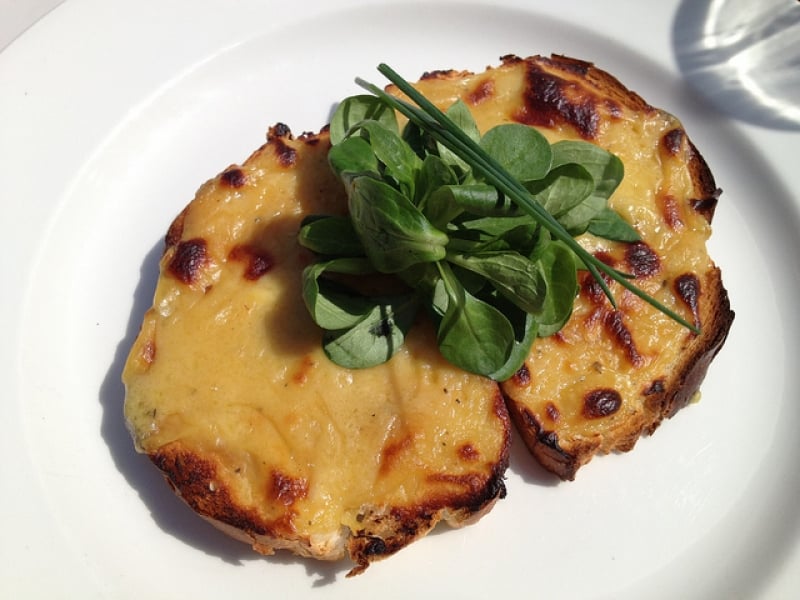
Image credit: Paul Townsend
Contrary to its moniker, the Welsh Rarebit contains no meat from the long-eared mammal. Rather, it is a slice of toast covered with a sauce of melted cheese and other ingredients like Worcestershire sauce, pepper and salt, mustard, and even beer, before being grilled in the oven. It can be served as is or topped with other food like a fried egg or tomato slices.
The name of the dish originates from 1725, where it was called ‘Welsh rabbit’, and changed over time to its current incarnation. Despite its misleading name, this comforting grilled cheese on toast is definitely something to try.
12. Bubble and squeak

Image credit: Matt Biddulph
This amusingly-named dish is made out of mashed potatoes and cabbages, which are usually leftovers from a roast dinner. Other leftover vegetables such as carrots and peas as well as leftover meat may also be added, and the mixture is fried in a pan until brown on the sides.
It is named as such because of the bubbling and squeaking noises that the cabbage makes during the cooking process. It is also traditionally a breakfast dish or an accompaniment to a full English breakfast.
13. Stargazy pie
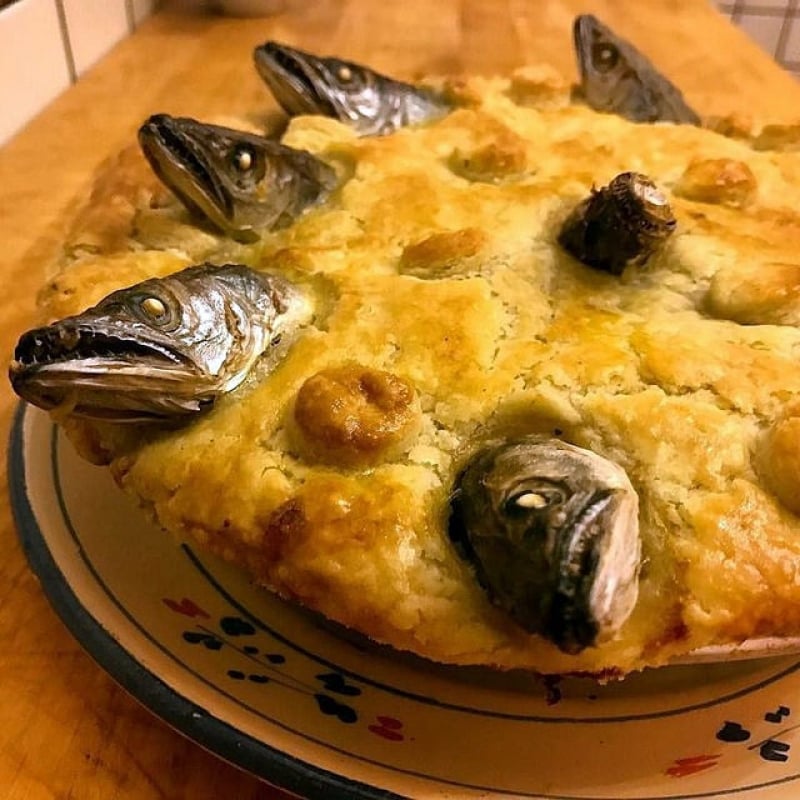
Image credit: Paul Townsend
Ever stared at a dish only to have it stare back at you? The stargazy pie is a fish pie made with eggs and potatoes, and features sardine heads sticking out of the crust, which allows the oils released during cooking to flow back into the pie.
The dish originated from the village of Mousehole in Cornwall. A 16th-century legend has it that a local fisherman named Tom Bawcock braved the stormy seas to catch enough fish to feed the starving village. He then baked it into a pie with the fish heads sticking out to prove there was fish inside. Since then, the village holds a celebration every 23rd December, which was the date that Bawcock performed his heroic deed, where villagers parade a huge Stargazy pie around town before eating it.
14. Scotch woodcock

Image credit: GeoTrinity
Another oddly-named British dish, a Scotch Woodcock is essentially just lightly scrambled eggs on toast with anchovy paste and pieces of anchovies on top. The creamy texture of the eggs, combined with the salty and fishy taste of anchovies and the crunchy piece of toast, makes it a great savoury snack.
A dish from the Victorian era in the 19th century, it has historically been served in the House of Commons in the UK, as well as the Universities of Oxford and Cambridge. Although it is a simple dish, it is steeped in tradition.
15. Toad in the hole
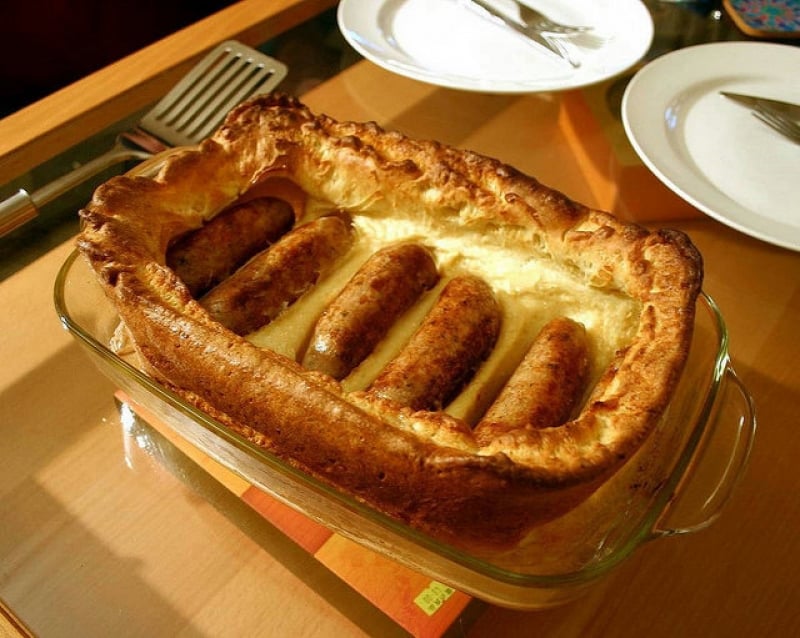
Image credit: Paul Townsend
For those with an aversion to eating amphibians, fear not, as a toad in the hole contains no actual toads. Rather, a toad in the hole is a traditional dish consisting of sausages baked in Yorkshire pudding. The origin of its name is unclear, although the sausages apparently look like toads submerged in mud (we don’t see the resemblance).
The sausages in the dish can be substituted for rump steak and lamb’s kidney, and the dish is best served with hot onion gravy. Don’t let the name put you off and have a taste of this unusual British dish!
16. Sticky toffee pudding
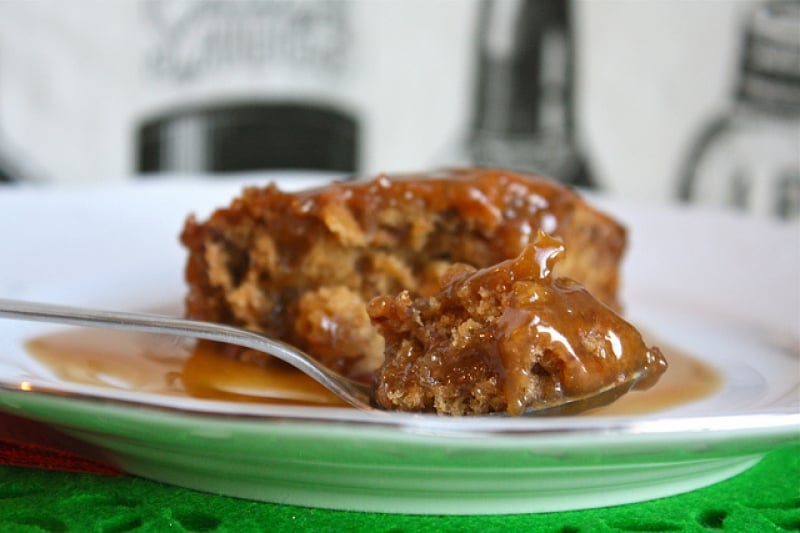
Image credit: Anne H. Putman
This British classic is the ultimate comfort dessert — a moist and stodgy sponge cake, made with chopped dates, is covered in a thick toffee sauce and served alongside vanilla ice-cream. Compared to other dishes on this list, this sweet treat is a relatively recent invention, having been invented in the 1970s by Francis Coulson and Robert Lee, at the Sharrow Bay Country House Hotel in the Lake District of North West England.
17. Deep-fried Mars bar
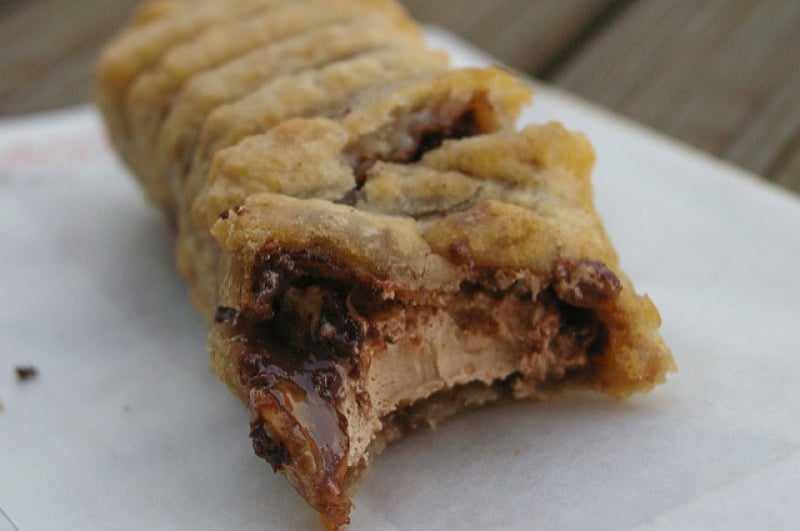
Image credit: Peter Shanks
The unofficial national dish of Scotland, together with haggis, the fried Mars bar is exactly how it sounds like. This unhealthy treat was created at the Carron Fish Bar in Stonehaven, a town near the city of Aberdeen, in 1995. The crunchy batter gives way to the gooey chocolate and caramel bar, making for a truly guilty dessert.
Apparently, the makers of the Mars bar have asked the Carron to make it clear that this specialty is not authorised or endorsed by the company, as it goes against their commitment to promoting ‘healthy, active lifestyles.’ While one wonders how the Mars bar itself is healthy, those on a diet should definitely stay away from this snack.
18. Spotted dick
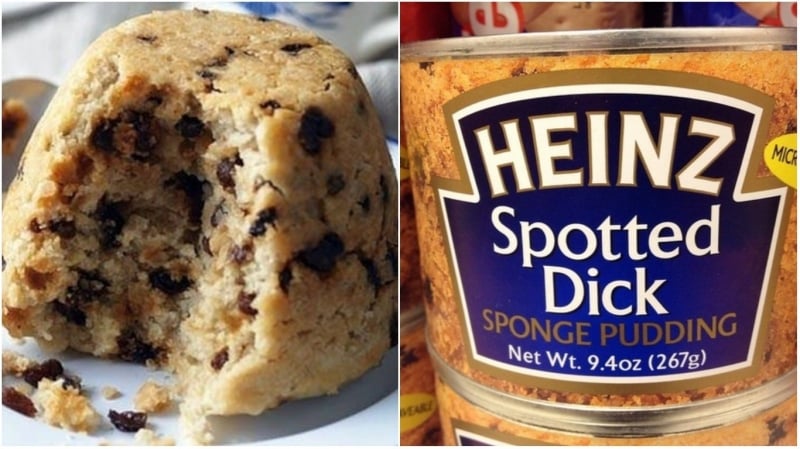
Image credit: (left) Paul Townsend, (right) Mike Mozart
The cause of many sniggers amongst British schoolboys, this unfortunately-named dish is actually just a sponge pudding made out of suet pastry with raisins and other dried fruits, which are the ‘spots’. As to why it is called ‘dick’, the word was commonly used to refer to pudding in the 19th century, and is possibly a corruption of the last syllable of ‘pudding’. It may also be a direct phonetic translation of dicht, which is ‘thick’ in German, perhaps referring to its texture.
Some places, including the UK House of Commons, have even renamed this dish to ‘Spotted Richard’ to save their blushes! Regardless of its dubious name, you definitely must try this old-school British dessert. Heinz has even manufactured a canned version, for you to bring back as an interesting souvenir for your friends.
Has this list whetted your appetite yet? Many British foods have had a long culinary history, and their naming quirks just make them even more intriguing. On your next trip to the UK, don’t be content with eating just fish and chips, make sure you try these interesting dishes for yourself!




